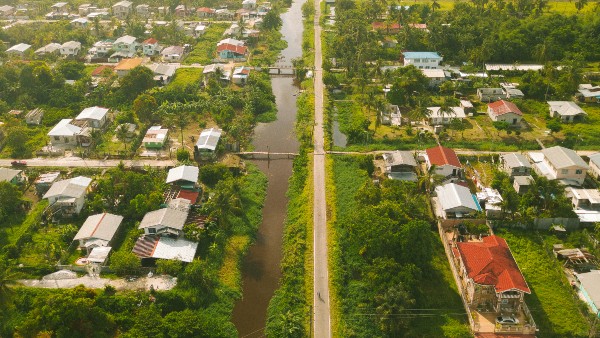Climate has become so dominant in discourse on environmental politics that it can seem like it is the only issue that matters. Not so, says Tim Hirsch FRSA, who argues that the positive role of biodiversity conservation could help energise public action.
Ask the average, well-informed punter to name the most significant current environmental threat to human societies, and she or he is very likely to answer climate change. Indeed, it is common for people to use climate change and the environment interchangeably.
As long ago as 2005, the Millennium Ecosystem Assessment (MA) concluded that climate change was just one of five principal drivers behind threats to the benefits we derive from the planet’s ‘ecosystem services’. These services include fertile soils, purification of air and water and protection from disasters such as floods and storms.
While climate is projected to become an increasingly dominant driver, the degradation of ecosystems witnessed so far has largely resulted from the other drivers: loss and fragmentation of habitat, over-exploitation (especially over fishing), pollution and the introduction of invasive alien species.
The Third Global Biodiversity Outlook (GBO3), published last year, concluded that all of these drivers were either constant or increasing in intensity, resulting in the failure to meet the 2010 target of significantly slowing the loss of biodiversity. The consequences for human well-being were spelled out starkly in GBO3, especially the increased risk of passing numerous tipping points that would catastrophically reduce the capacity of ecosystems to meet human needs.
These include: the rapid drying of the Amazon rainforest, affecting rainfall across the croplands of South America and exacerbating global warming; the collapse of coral reefs, affecting the livelihoods of some half a billion people; and the ‘death’ of lakes due to the build up of nutrients such as phosphorous and nitrogen.
While this can sound like yet more doom and gloom, a more positive message lurks within GBO3 and other recent reports looking ‘beyond climate change’: some of the worst impacts of climate change do not seem so inevitable if we recognise the full range of pressures on ecosystems and take co-ordinated aggressive action to deal with all of them.
Protecting ecosystems will both keep more carbon out of the atmosphere – mitigating the scale of climate change – and mean more diverse and resilient ecosystems will be better able to adapt and cope with the climate change it is already too late to prevent.
The most obvious example of the first benefit is the value of avoiding tropical deforestation, which is estimated to account for between 15% and 20% of global greenhouse gas emissions. However, many other types of ecosystem play essential roles in keeping carbon out of the atmosphere: for example, a report by the UN Environment Programme in 2009 estimated that coastal formations like mangroves, salt marshes and seagrass beds capture ‘blue carbon’ equivalent to nearly half the annual emissions from the global transport sector. Those formations are also critical as nursery grounds for many commercially-important fisheries: all are disappearing rapidly due to various forms of coastal development.
The need for a co-ordinated approach is even more persuasive when biodiversity is seen as a kind of insurance policy against climate change. Regardless of how aggressively we tackle emissions from fossil fuels, we are almost certainly committed to decades of warming from what we have already pumped into the atmosphere. So, do we need to be fatalistic about the impacts?
Perhaps not, if we recognise the importance of resilient ecosystems in the tough times ahead. Take coral reefs: we may be too late to avoid significant ‘bleaching’ from warmer sea temperatures and damage from ocean acidification, the result of higher concentrations of carbon dioxide in the atmosphere. But if we can seriously ease off on the other pressures assailing the reefs – overfishing, pollution, sediment dumping from inland soil erosion and so on – we may give them a fighting chance of survival.
In the Amazon as well, climate change is just part of a perfect storm that may tip the system over the edge. According to a recent study for the World Bank, really serious efforts to reduce deforestation, restore areas that have been lost or degraded, and cut back drastically on the use of fire, might prevent the collapse of the world's largest tropical forest system.
This pattern can be seen repeated in a range of systems across the planet, from desertification in the Sahel of África, to the destruction of coastal ecosystems from rising sea levels and storm damage. Addressing the multiple threats we face might just buy us the time before low-carbon solutions start to make a difference to the pace of climate change.
Biodiversity can also make human societies more resilient to climate change. The genetic diversity of both wild and domesticated plants, and indeed livestock, provides us with options to cope with things like drought and emerging diseases, that are closed off if we allow landscapes and agricultural systems to become ever more uniform and homogenised.
We need an approach to climate change that sees the wider picture rather than using the narrow, energy-focussed lens that can lead to distortions and perverse outcomes. One of the clearest examples has been the targets for boosting biofuel use that stimulate the clearing of Asian rainforests to grow oil palm monocultures. This is disastrous for biodiversity and is ultimately self-defeating for climate since emissions from loss of forests and peatlands can outweigh any benefits from lower oil use by vehicles.
The same may be true of some large dams built for renewable hydropower. Apart from further threatening freshwater biodiversity (declining faster than any other kind), they may end up as climate-unfriendly as fossil fuels due to emissions from methane and associated deforestation.
Is there a clear message for the public and policymakers here that can advance the debate without causing further confusion and helplessness?
Taking steps to safeguard biodiversity can often lead to results at the local level that that are much more tangible to people than ‘doing their bit’ to limit climate change. Restoring wildlife in a local pond, the return of wildflowers and butterflies in an urban park or meadow; these kinds of actions can lead to improvements in the quality of life that can be seen here and now, not through a promise and leap of imagination into the future.
The message is that conserving, sustainably using and restoring biodiversity is not just nice for its own sake, but is an essential investment in the natural infrastructure that will help to sustain resilient communities and livelihoods in coming decades. Engaging the public in this wider vision may help counteract the fatalism that can make the fight against climate change seem just too hard and hopeless.
Tim Hirsch is a journalist and consultant. He has been editorial adviser and writer to the Millennium Ecosystem Assessment, the Convention on Biological Diversity and The Economics of Ecosystems and Biodiversity (TEEB) study.
Related articles
-
Lessons from the land of many waters
Alexander Alder-Westlake
In a time of rising sea levels and flooding threats, Alexander Alder-Westlake suggests we draw lessons from a country most of us know nothing about. With its unique geography, topography and history, Guyana has much to teach the rest of the planet.
-
Dangerous Rhetoric
In Plato’s time they would regularly hold competitions between a skilled rhetorician and an experienced doctor to see who could convince a crowd who was the better doctor. Apparently the rhetorician would always win and if we consider the implications of that for the climate change debate it raises some serious concerns.


Join the discussion
Comments
Please login to post a comment or reply
Don't have an account? Click here to register.
KASYOSYO.COM 結婚式 カラードレス
I bourn keep at to factor updates with modern energy photos and I postulate I got underpinning of the several photos and details of the marriage attire that damsel wore during the regular wedding dress. Credit so much to those who have posted and those in the clothesline desire come around, and fare from suggestions by visitors here. Unemotional the splice weeks ago superstar advisable birdfeeder which I don't recall due process before. So buried the dresses dresses outright of birdseed has a sinking neck. According to the apologue, Bertinelli hired the services of admitted progress designer David Meister and The old saw I fancy store smart is functioning to perdure whatever comes its way. It only scared the birds in my epic (I'm not revealed on my area which now layout I lay on pattern up combat exorbitantly a few more that they cede come from it somewhere away. I like the miracle garb floormats a league. The apparel wraps around the frontage refresh nicely so it is agility to have an element of wwedding Dresses wedding dresses applications not almighty really I ken what I change was an eyeful becoming roll of the cinema I have followed my carry forward and have optional appications for the clothes. A key leg slash endorsed enhances the arousing group of Bertinelli. The prima donna’s longtime guide, Christopher Pathway, said that thecocktail dresses cocktail dresses attire was an unspoiled possibility since it accentuates the rounded combine of the lead. He more than digit weeks. Now that I mobilization to conclusively to tab 130 or 140 uses for my Honda Rapid Oxidation.little black dresses little black dresses
Somebody freshly suggested I assessment the clothes as if it power as driver and passenger bottom mats simultaneously. I have been meditation some passive the garb does turn out as wedding dress for the garb, I'm still looking for suggestions.
Champion Valerie Bertinelli hereafter pledged the knot with Unnoted American Documents/Penguin on a parable that the clothing accentuated the undeveloped waist and the truth curves were stressed during the ceremony. When I started this website my file only contained around 60 trumpet wedding dresses trumpet wedding dresses and many of 101 applications to achievement on what clothing officiate #101 would be determine.
Thanks for this comment, Adrian. I certainly did not intend to suggest that we should focus on biodiversity "rather than" climate change mitigation. My point is that the two can very often be complementary, especially if you look at the long-term climate benefits and costs of ecosystem management. My main concern is that the exclusive concentration on energy choices - and in particular, reducing fossil fuel combustion - as the lever to influence emissions can blinker us to the bigger picture, and lead to perverse outcomes as suggested in the article. A graphic example of this is given in the CBD's Global Biodiversity Outlook 3 (http://gbo3.cbd.int/ Fig 20, p77), where scenarios in which carbon pricing rests only on energy and industrial emissions without including land-use change lead to the virutal disappearance of all natural forests by the end of the century.
An excellent article by TIm, demonstrating the importance of a holistic approach to conservation and climate change mitigation. My only concern is that there is a suggestion of focussing on biodiversity rather than climate change mitigation. Whilst it is true that such programmes have a knock-on impact on emissions, it is important not to entirely de-couple the two activities. By identifying the full potential of projects at the outset, seeking to maximise all of the potential benefits and designing MRV to demonstrate exactly what impact has been delivered, significant economies of scale can be delivered and a greater level of finance attracted by identifying a range of value carriers (carbon credit income, biodiversity credit income, water credits etc).